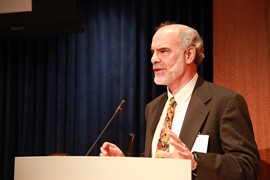WASHINGTON -- At an event heralding the launch of a new clinical trial that tests tuberculosis drugs in combination, a senior USAID official said he wanted researchers and those who oversee programs in countries to work more closely together.
Robert Clay, Deputy Assistant Administrator in USAID’s Global Health Bureau, told a packed audience at the Kaiser Family Foundation in Washington, D.C., that “past polarization of research and implementation is really something that we have to overcome.
“The researchers have to understand the barriers that implementers are facing to work through these programs, and the implementers have to understand the kinds of studies that are being carried out, and looking at these results to translate that in real time to policymakers,” he said.
Clay said these kinds of working relationships were especially important in a time of tight financial resources. Speaking about efforts to fight TB, he said, “No one group can address this alone. … We’re going to have to be working together to grow the pie.”
The event, which was organized by the Critical Paths to TB Drug Regimens, featured the announcement by TB Alliance of a Phase 2 clinical trial involving a three-drug combination therapy. Two were novel drug candidates and the third is now being used in other regimens. The Alliance aims to hold back several TB drugs at once in hopes of finding new regimens that can cure strains of TB that are resistance to many current medications.
The new clinical trial, which was launched on Monday, will take place in eight countries over the next two months. Results won’t be known for another year.
Clay said that the current situation in fighting TB – no new drugs in 47 years, a vaccine that is not effective for adults, and the most common diagnostic tool more than a century old – is the price paid for long-time neglect.
“Progress in TB has been slowed by inefficient investments we have made in diagnostics, drugs and vaccines,” he said. “We’ve seen … essentially almost nothing in the past 50 years for drugs, and that is clearly an area we need to focus on much more. For diagnostics, a lot of what we are doing is relying on a 19th century tool, the microscope. Unless we have new technologies, we are not going to meet the goal of TB elimination in 2030.”
If efforts succeed in finding new drugs, he said, “it will likely be more cost effective, be a shorter drug regime, reduce lost work time, and lessen the economic impact of TB, which will benefit the individuals. It also will help stabilize families and communities and save and enrich the lives of millions of children.”
Cure All: Global Impact- Dr. Robert Clay from TB Alliance on Vimeo.


